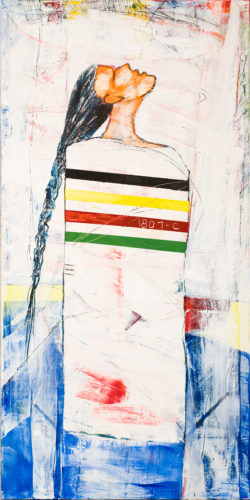
Walk into the spacious Barker Gallery at the Jordan Schnitzer Museum of Art in the next couple months and you’ll find yourself face to face with a large oil painting that seems to feature a totem pole in an Oregon Coast wetland.
But look again, and it’s no ordinary totem pole. Oregon painter Michael Brophy’s “Beaver Trade” shows a log with one animal face carved into it, lower down, but above that the imprints of a logger’s caulk boots leading to the top.
In place of a traditional western landscape painting exalting the frontier landscape and perhaps exoticizing Native culture, “Beaver Trade” takes a hard swing at the colonial nature of America’s westward expansion.
That is the point of Many Wests: Artists Shape an American Idea, a traveling exhibition put together by curators at four Western art museums — including the Schnitzer — and a curator from the Smithsonian American Art Museum. The other partner museums are Boise Art Museum in Idaho, the Utah Museum of Fine Arts in Salt Lake City and the Whatcom Museum in Bellingham, Washington.
Traditional art of the American West, from C.M. Russell’s turn of the 20th century cowboy paintings and sculptures to Albert Bierstadt’s lush landscapes, “carries a very loaded and problematic history,” says the Schnitzer’s McCosh curator, Danielle Knapp, who has been working with the other curators on the project since 2018. “There are no Bierstadt paintings here,” she says, dismissing them as “a colonialist vision of the West.”
Instead, Many Wests offers a critique of that familiar if fanciful Western mythology. The show mostly includes contemporary work, much of it by Indigenous artists. Among those is Oregon’s late visionary painter Rick Bartow; his large self portrait “Buck” shows him as a haunted Vietnam veteran in a wheelchair, along with the words “Indian hero.” More upbeat, but equally caustic, is work by Portland artist Wendy Red Star, whose engaging staged color photographs titled “Four Seasons” show her in tribal dress — she is Apsáalooke (Crow) — in front of painted Western backdrops, with figures of animals arrayed around her like a department store window display.
The “West” of myth didn’t exist only in the United States. A fascinating project by U.S. photographer David Taylor, who got his MFA at the UO in 1994, and Mexican sculptor Marcos Ramírez ERRE can grab your attention and suck you into a detailed vortex of wonder. “DeLIMITtations” offers a grid of 48 separately framed landscape photos taken by Taylor along the long-forgotten 1821 border between Mexico and the U.S. — the border lay just south of Oregon, meaning all of California and the Southwest was part of Mexico — marking each with new border monuments by ERRE.
Many Wests has already been exhibited in Boise and Bellingham; after it wraps up Dec. 18 at the JSMA it will head to Salt Lake City and then, finally, to the Smithsonian, where it is to open July 28, 2023.
The exhibition comes at a time of much dialogue around myths and visions of the American West. The Amon Carter Museum of American Art in Fort Worth, Texas, is now showing Stephanie Syjuco: Double Vision, an elaborate visual critique by Syjuco, a multimedia artist in Oakland, California, of the Amon Carter’s collection of traditional Western art, from Bierstadt to Frederic Remington.
Many Wests: Artists Shape an American Idea continues at the Jordan Schnitzer Museum of Art, on campus at the University of Oregon, through Dec. 18. Admission is $5. Artist talks will be given by V. Maldonado on Oct. 23, by Ka’ila Farrell-Smith on Nov. 5 and by Marie Watt on Nov. 10.